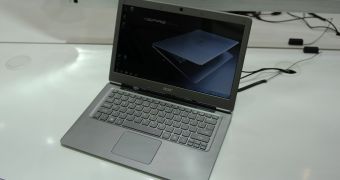Ultrabooks manufacturers who plan to release such devices under the $1000 US price tag recommended by Intel are considering using hybrid storage solutions, comprised on an SSD and a hard drive, for their creations in order to keep production costs down and improve their margins.
Such solutions are made possible by the integration of Intel's Smart Response Technology (SRT) that can use a small SSD as a fast cache for a hard drive.
By going this route, notebook makers will be able to cut somewhere between 10 to 15 percent of the total cost of an Ultrabook while also respecting Intel's guidelines for these devices that call for a boot-up time between 8-45 seconds and a physical size smaller than that of a standard 9.5mm hard drive.
The move to hybrid storage solutions will also enable notebook makers to increase the profit margins of such devices.
Furthermore, while there isn't any chance for hybrid drives to surpass SSDs in raw speed, these are able to provide much larger capacities at a much lower price tag.
Acer has already used such a configuration in the cheaper versions of the Aspire S3 Ultrabook that pairs a 320GB hard-disk drive with a 20GB SSD.
Shortly after Intel announced its Ultrabook concept, a lot of voices in the industry have started complaining about the high costs associated with the fabrication of such notebooks.
Apart from the high prices associated with solid state storage, Ultrabook makers also complained about other hardware costs involved in the design of these systems such as the unibody chassis, high-density li-polymer batteries and Intel ULV Sandy Bridge processors.
All these factors had an impact not only on the final sale price of the resulting Ultrabooks, but also meant that notebook makers would have to decrease their profit margins to a level that made them feel uncomfortable. (via DigiTimes)

 14 DAY TRIAL //
14 DAY TRIAL //